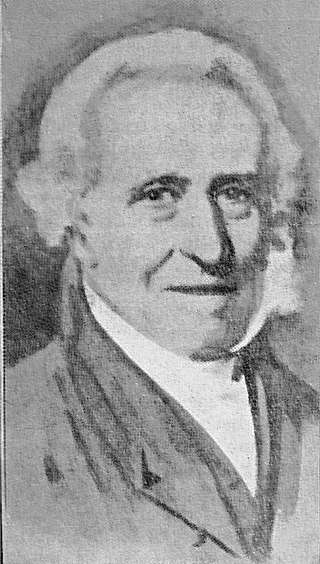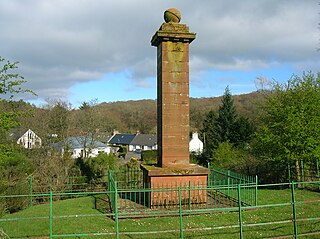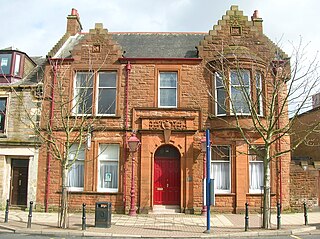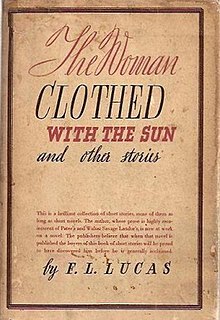The Buchanites were the late 18th-century followers of Elspeth Buchan, a Scottish woman who claimed to be the Woman Clothed with the Sun, one of the figures named in the Book of Revelation.
Elspeth Buchan (1738–1791) was the founder of a Scottish religious sect known as the Buchanites.

Salute to Adventurers is a 1915 historical adventure novel by the Scottish author John Buchan. Largely set among the newly-settled Virginia plantations of the late 17th century, the novel includes a number of historical characters and events, including the wild and radical preaching of John Gibb, founder of the Sweet Singers sect.

During the years 1781–1782, at the age of 23, Robert Burns (1759–1796) lived in Irvine, North Ayrshire for a period of around 9 months, whilst learning the craft of flax-dressing from Alexander Peacock, who may have been his mother's half-brother, working at the heckling shop in the Glasgow Vennel. Dr John Cumming of Milgarholm, a provost of Irvine, claimed that he had invited Burns to come to Irvine to learn flax dressing. During this time he made a number of acquaintances, befriended several locals and took regular walks into the Eglinton Woods via the old Irvine to Kilwinning toll road and the Drukken or Drucken (Drunken) Steps. Steps over the Red Burn and back via the site of Saint Brides or Bryde's Well at Stanecastle. Burns had several other connections with the Eglinton Estate and other branches of the Montgomerie family. He probably left in March 1782.

The Drukken, Drucken Steps or Drunken Steps were stepping stones across the Red Burn in Irvine, North Ayrshire, Scotland and are associated with Scotland's national poet, Robert Burns. Drukken is used on the commemorative cairn plaque, but Druken or Drucken may also be used.

Seagate Castle is a castle in North Ayrshire, in the town of Irvine, close to the River Irvine, Scotland. The castle was formerly a stronghold, a town house, and later a dower house of the Montgomery Clan. The castle overlooks the oldest street in Irvine, which was once the main route between the town and the old harbour at Seagatefoot, which by 1606, was useless and abandoned due to silting. The remains of the castle are protected as a scheduled ancient monument.
Jean Glover or Jennifer Glover (1758–1801) was a Scottish poet and singer. She was the daughter of James Glover, handloom weaver and Jean Thomson, born in Townhead, Kilmarnock; was well educated for the time she lived in, clever and sharp-witted. She had a fine singing voice and exceedingly good looks of "both face and figure".

Trindlemoss Loch, Scott's / Scot's Loch or the Loch of Irvine was situated in a low-lying area running from Ravenspark to near Stanecastle and down to Lockwards, now represented only by the playing fields off Bank Street in the Parish of Irvine, North Ayrshire, Scotland. The loch was natural, sitting in a hollow created by glaciation. The loch waters were progressively drained and in 1691 this was finally achieved.

John MacKenzie (c.1755–1837) was a Scottish army surgeon. He was a native of Ayrshire, where he married Helen Miller (d.1827), one of the "Six proper Mauchline belles" who is buried in Irvine's Old Parish church. He was a member with Robert Burns of the St James Lodge, Tarbolton. His house in Mauchline is now the 'Burns House Museum,' run by East Ayrshire Council. MacKenzie wrote "Origin of Morals and Common Sense."
Janet, Jennie or Jenny Clow was a domestic servant to Mrs Agnes Maclehose, née Craig (1759-1841), the Clarinda to Robert Burns' Sylvander. She was the daughter of Andrew Clow and Margaret Inglis from Fife and was the youngest of eight children. Her mistress sent her to deliver a letter to the poet and he seduced her.

Helen Anne Park, known as Anna Park or Ann Park, was born in 1769 at Moffat, Scotland. She was thought to have been the daughter of Joseph Park, an Edinburgh coachmaker, and Jean Dick. However, recent research has shown that she was actually the daughter of Walter Park and Elizabeth Blacklock. Margaret Ewing nee Park, a onetime landlady of 'The Globe', was her sister and she worked there as a barmaid. Anna bore the poet Robert Burns an illegitimate child named Elizabeth 'Betty' Burns as a result of an adulterous affair.

Mary Campbell, also known as Highland Mary, was the daughter of Archibald Campbell of Daling, a sailor in a revenue cutter, whose wife was Agnes Campbell of Achnamore or Auchamore. Mary was the eldest of a family of four. Robert Burns had an affair with her after he felt that he had been "deserted" by Jean Armour following her move to Paisley in March 1786. The brief affair started in April 1786, and the parting took place on 14 May of that year. Her pronunciation of English was heavily accented with Gaelic and this led to her becoming known as 'Highland Mary.'

The Irvine Burns Club, based at the Wellwood Burns Centre & Museum, was founded on 2 June 1826 and is one of the world's longest continuously active Burns Clubs. At least five personal friends of Robert Burns were among the group of local gentleman, whose idea it was to form the club. Irvine in North Ayrshire is an old market town and port situated on the west coast of Scotland, approx 14 miles north of Ayr.

David Sillar (1760–1830) was a Scottish farmer, poet, grocer, schoolteacher and baillie who was a close friend of the poet Robert Burns. He died in 1830, aged 70, after a long illness, and was buried in Irvine's Old Parish Church cemetery. His eroded gravestone was replaced by a facsimile thanks to the Irvine Burns Club. He married twice and had only one son survive him, a Dr. Zachary Sillar M.D. of Liverpool. His father was Patrick Sillar, tenant farmer at Spittalside near Tarbolton, Ayrshire. He first married a widow, Mrs Margaret Kerr, née Gemmell shortly after moving to Irvine and had seven children and his second wife was the sister of John Bryan of the Sun Inn, Kilmarnock.

Robert Burnes or Robert Burness was a paternal uncle of the poet Robert Burns. He left the family farm of Clochnahill or Clokenhill in Kincardineshire with his younger brother William Burnes, and found work at the Lochridge or Lochrig limestone quarries and lime kilns that lay near Byrehill Farm near Stewarton. He was a teacher, a gardener later in life and a land steward on the nearby Robertland Estate, possibly through the influence of his nephew. Robert Burns referred to his him as Poor Uncle Robert upon his death in 1789.
Events from the year 1784 in Scotland.

The Woman Clothed with the Sun; being The Confession of John McHaffie concerning his sojourn in the Wilderness among the folk called the Buchanites, is a historical novella by the British writer F. L. Lucas. It purports to be an account, written in 1814 by a Scottish minister of the Kirk in middle age and published posthumously, of his youthful bewitchment by Elspeth Buchan and of the time he spent in the 1780s among the Buchanites. First published in 1937, it was Lucas's second historical novella, the first being The Wild Tulip (1932); he had also published a prize-winning historical novel, Cécile (1930).

Dalgarnock, Dalgarno, Dalgarnoc was an ancient parish and a once considerable sized village in the Nithsdale area of Dumfries and Galloway, Scotland, south of Sanquhar and north of Dumfries that enclosed the parish of Closeburn but was annexed to Closeburn in 1606 following the Reformation, separated again in 1648 and finally re-united in 1697, as part of the process that established the Presbyterian Church of Scotland. It was a burgh of regality bordering the River Nith and Cample Water and held a popular market-tryst or fair from medieval times until 1601 when the Earl of Queensberry had them transferred to Thornhill, commemorated in song by Robert Burns, shortly before its demise and now only a remote churchyard remains at a once busy site.
Adam Armour (1771–1823) was the younger brother of Jean Armour and therefore the brother-in-law of the poet Robert Burns. In addition, being married to Fanny (Frances) Burnes, he was also related to the poet through his father-in-law 'Poor Uncle Robert', who lived at Stewarton.
James Armour was a master mason and father of Jean Armour, and therefore the father-in-law of the poet Robert Burns. His birth year was shown here as 1730. The Scotland's People database has no record of this year of birth for a James Armour. Wikitree and several other data sources have his birth date as 10th/24th January 1731. The Scotland's People database has this record but showing his baptism on 24 January 1731. His birth on the original Old Parish Record is shown as 15 January 1731 to John Armour and Margrat(sic) Picken in Kilmarnock. James named his first son John which would normally be after James's father i.e. John. The chances of there being two James's born on exactly the same date exactly one year apart appear very remote and the naming of the first child seems to validate the conclusion that James Armour was born in 1731 and not 1730.


















